Closing the Gap Program: Health, Culture, and First Australian Jobs
VerifiedAdded on 2023/06/04
|11
|2825
|399
Report
AI Summary
This report critically examines the Australian Government's 'Closing the Gap' program, focusing on its target to reduce employment inequalities between Indigenous and non-Indigenous Australians. The report highlights the program's aim to improve health and wellbeing by increasing employment opportunities for Indigenous communities. It evaluates the strategies employed, such as skills training, cultural diversity initiatives, and anti-discrimination policies, and assesses their effectiveness based on current statistics. The analysis reveals that despite these efforts, a significant employment gap persists, indicating the program's failure to meet its targets. The report further suggests alternative strategies, including increased community development, improved education attendance, and promotion of self-learning, to enhance Indigenous participation in the workforce and ultimately close the employment gap. It concludes that a multifaceted approach is necessary to address the complex factors contributing to employment disparities and improve the overall health and wellbeing of Indigenous Australians.
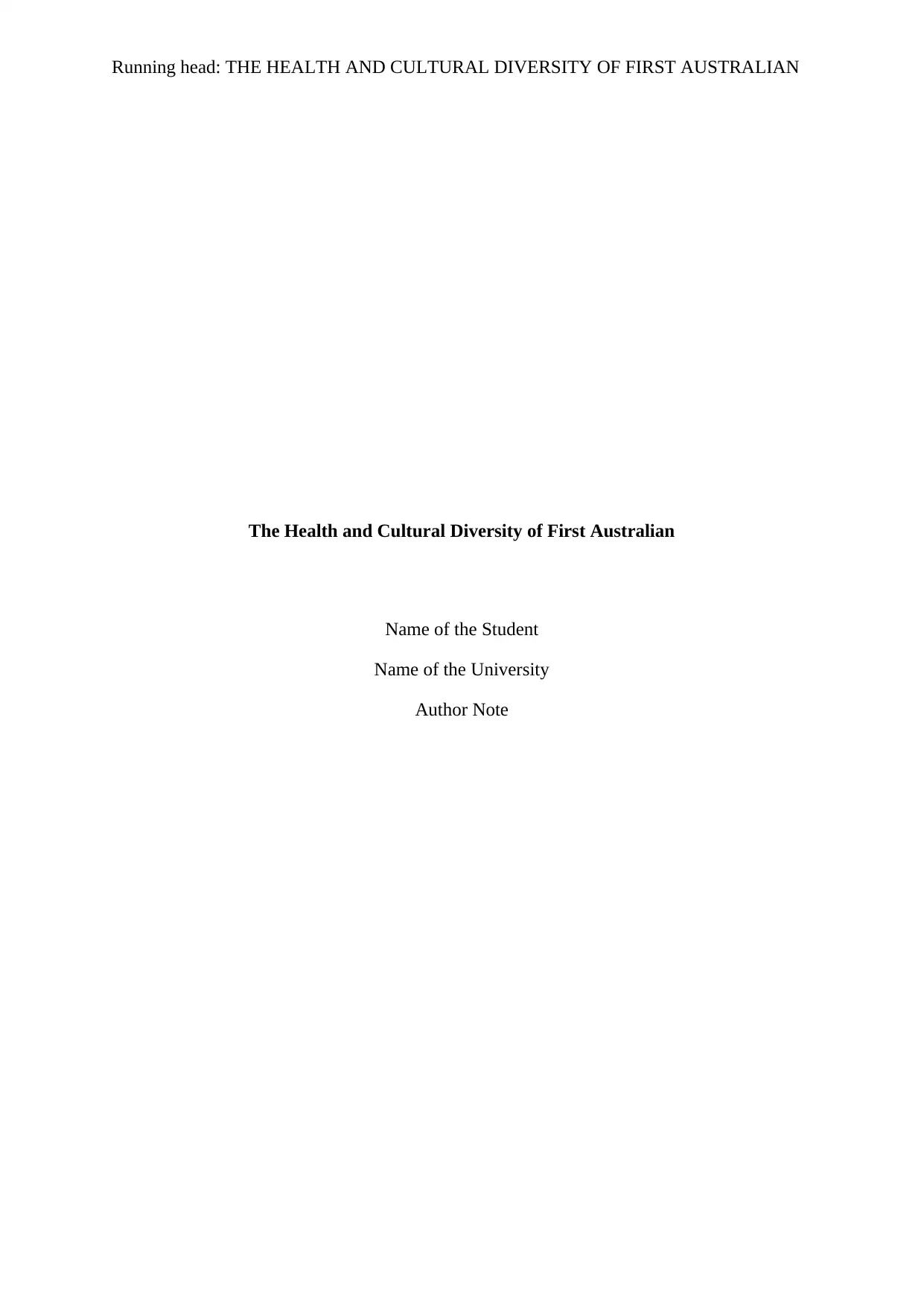
Running head: THE HEALTH AND CULTURAL DIVERSITY OF FIRST AUSTRALIAN
The Health and Cultural Diversity of First Australian
Name of the Student
Name of the University
Author Note
The Health and Cultural Diversity of First Australian
Name of the Student
Name of the University
Author Note
Paraphrase This Document
Need a fresh take? Get an instant paraphrase of this document with our AI Paraphraser
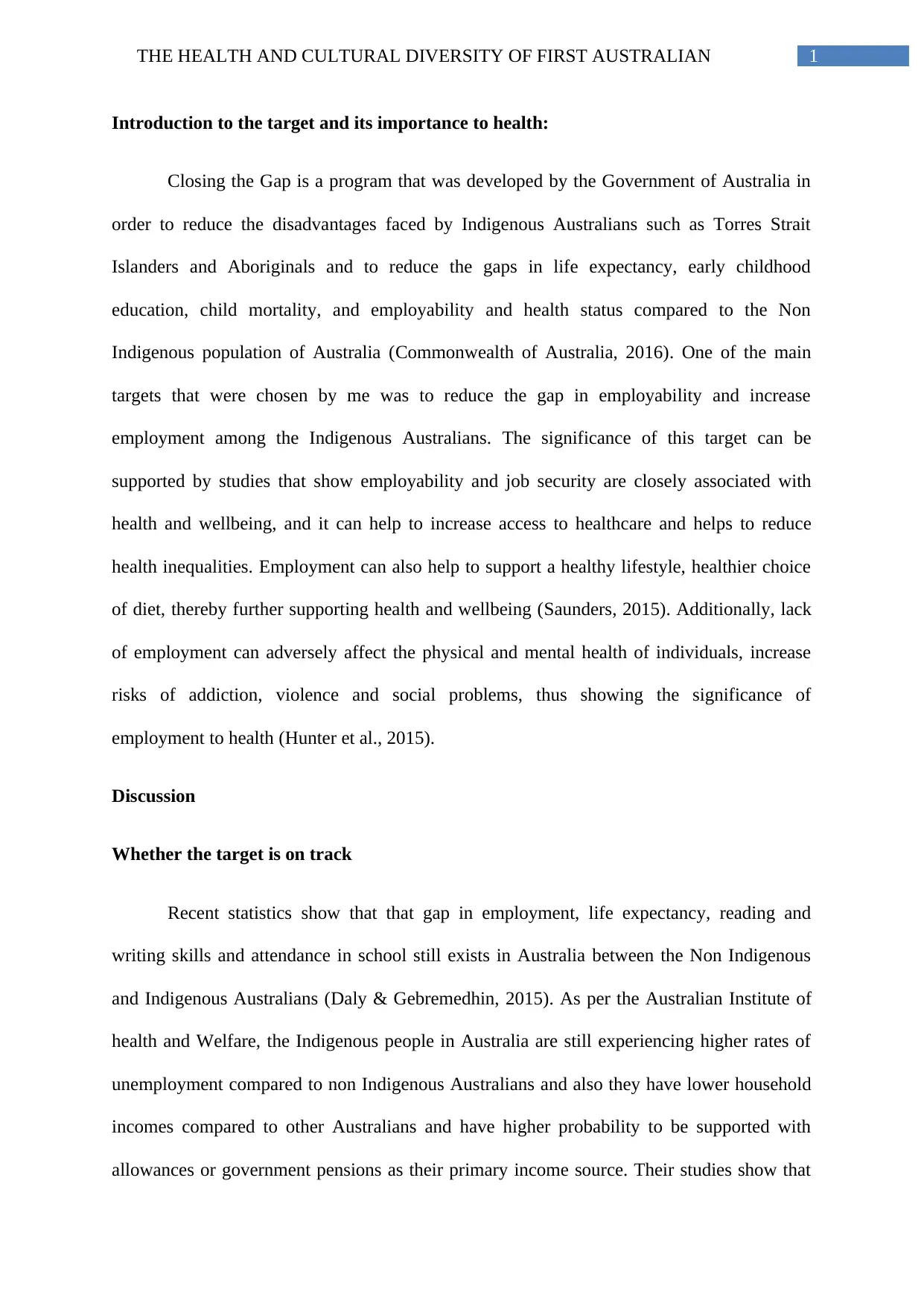
1THE HEALTH AND CULTURAL DIVERSITY OF FIRST AUSTRALIAN
Introduction to the target and its importance to health:
Closing the Gap is a program that was developed by the Government of Australia in
order to reduce the disadvantages faced by Indigenous Australians such as Torres Strait
Islanders and Aboriginals and to reduce the gaps in life expectancy, early childhood
education, child mortality, and employability and health status compared to the Non
Indigenous population of Australia (Commonwealth of Australia, 2016). One of the main
targets that were chosen by me was to reduce the gap in employability and increase
employment among the Indigenous Australians. The significance of this target can be
supported by studies that show employability and job security are closely associated with
health and wellbeing, and it can help to increase access to healthcare and helps to reduce
health inequalities. Employment can also help to support a healthy lifestyle, healthier choice
of diet, thereby further supporting health and wellbeing (Saunders, 2015). Additionally, lack
of employment can adversely affect the physical and mental health of individuals, increase
risks of addiction, violence and social problems, thus showing the significance of
employment to health (Hunter et al., 2015).
Discussion
Whether the target is on track
Recent statistics show that that gap in employment, life expectancy, reading and
writing skills and attendance in school still exists in Australia between the Non Indigenous
and Indigenous Australians (Daly & Gebremedhin, 2015). As per the Australian Institute of
health and Welfare, the Indigenous people in Australia are still experiencing higher rates of
unemployment compared to non Indigenous Australians and also they have lower household
incomes compared to other Australians and have higher probability to be supported with
allowances or government pensions as their primary income source. Their studies show that
Introduction to the target and its importance to health:
Closing the Gap is a program that was developed by the Government of Australia in
order to reduce the disadvantages faced by Indigenous Australians such as Torres Strait
Islanders and Aboriginals and to reduce the gaps in life expectancy, early childhood
education, child mortality, and employability and health status compared to the Non
Indigenous population of Australia (Commonwealth of Australia, 2016). One of the main
targets that were chosen by me was to reduce the gap in employability and increase
employment among the Indigenous Australians. The significance of this target can be
supported by studies that show employability and job security are closely associated with
health and wellbeing, and it can help to increase access to healthcare and helps to reduce
health inequalities. Employment can also help to support a healthy lifestyle, healthier choice
of diet, thereby further supporting health and wellbeing (Saunders, 2015). Additionally, lack
of employment can adversely affect the physical and mental health of individuals, increase
risks of addiction, violence and social problems, thus showing the significance of
employment to health (Hunter et al., 2015).
Discussion
Whether the target is on track
Recent statistics show that that gap in employment, life expectancy, reading and
writing skills and attendance in school still exists in Australia between the Non Indigenous
and Indigenous Australians (Daly & Gebremedhin, 2015). As per the Australian Institute of
health and Welfare, the Indigenous people in Australia are still experiencing higher rates of
unemployment compared to non Indigenous Australians and also they have lower household
incomes compared to other Australians and have higher probability to be supported with
allowances or government pensions as their primary income source. Their studies show that
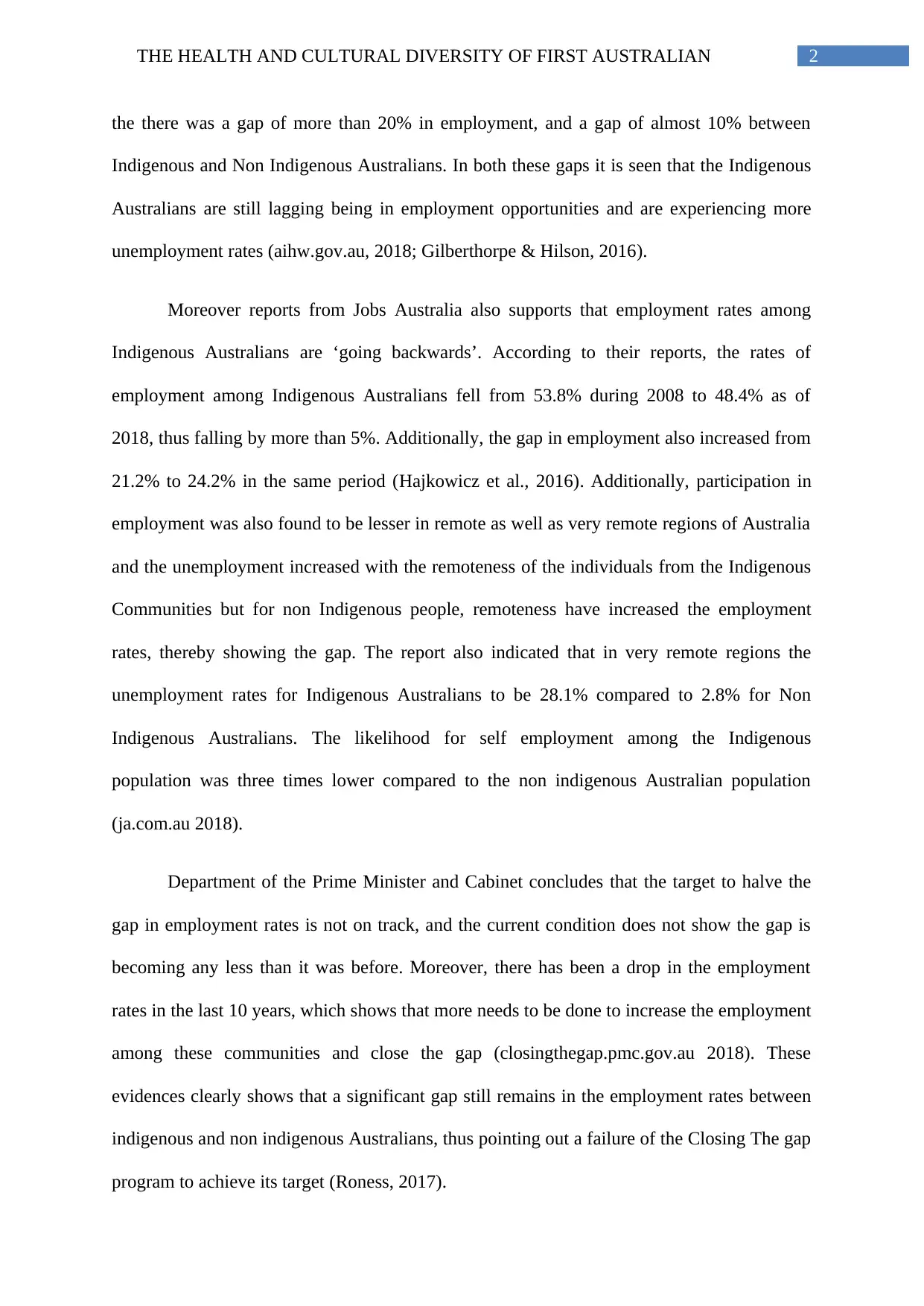
2THE HEALTH AND CULTURAL DIVERSITY OF FIRST AUSTRALIAN
the there was a gap of more than 20% in employment, and a gap of almost 10% between
Indigenous and Non Indigenous Australians. In both these gaps it is seen that the Indigenous
Australians are still lagging being in employment opportunities and are experiencing more
unemployment rates (aihw.gov.au, 2018; Gilberthorpe & Hilson, 2016).
Moreover reports from Jobs Australia also supports that employment rates among
Indigenous Australians are ‘going backwards’. According to their reports, the rates of
employment among Indigenous Australians fell from 53.8% during 2008 to 48.4% as of
2018, thus falling by more than 5%. Additionally, the gap in employment also increased from
21.2% to 24.2% in the same period (Hajkowicz et al., 2016). Additionally, participation in
employment was also found to be lesser in remote as well as very remote regions of Australia
and the unemployment increased with the remoteness of the individuals from the Indigenous
Communities but for non Indigenous people, remoteness have increased the employment
rates, thereby showing the gap. The report also indicated that in very remote regions the
unemployment rates for Indigenous Australians to be 28.1% compared to 2.8% for Non
Indigenous Australians. The likelihood for self employment among the Indigenous
population was three times lower compared to the non indigenous Australian population
(ja.com.au 2018).
Department of the Prime Minister and Cabinet concludes that the target to halve the
gap in employment rates is not on track, and the current condition does not show the gap is
becoming any less than it was before. Moreover, there has been a drop in the employment
rates in the last 10 years, which shows that more needs to be done to increase the employment
among these communities and close the gap (closingthegap.pmc.gov.au 2018). These
evidences clearly shows that a significant gap still remains in the employment rates between
indigenous and non indigenous Australians, thus pointing out a failure of the Closing The gap
program to achieve its target (Roness, 2017).
the there was a gap of more than 20% in employment, and a gap of almost 10% between
Indigenous and Non Indigenous Australians. In both these gaps it is seen that the Indigenous
Australians are still lagging being in employment opportunities and are experiencing more
unemployment rates (aihw.gov.au, 2018; Gilberthorpe & Hilson, 2016).
Moreover reports from Jobs Australia also supports that employment rates among
Indigenous Australians are ‘going backwards’. According to their reports, the rates of
employment among Indigenous Australians fell from 53.8% during 2008 to 48.4% as of
2018, thus falling by more than 5%. Additionally, the gap in employment also increased from
21.2% to 24.2% in the same period (Hajkowicz et al., 2016). Additionally, participation in
employment was also found to be lesser in remote as well as very remote regions of Australia
and the unemployment increased with the remoteness of the individuals from the Indigenous
Communities but for non Indigenous people, remoteness have increased the employment
rates, thereby showing the gap. The report also indicated that in very remote regions the
unemployment rates for Indigenous Australians to be 28.1% compared to 2.8% for Non
Indigenous Australians. The likelihood for self employment among the Indigenous
population was three times lower compared to the non indigenous Australian population
(ja.com.au 2018).
Department of the Prime Minister and Cabinet concludes that the target to halve the
gap in employment rates is not on track, and the current condition does not show the gap is
becoming any less than it was before. Moreover, there has been a drop in the employment
rates in the last 10 years, which shows that more needs to be done to increase the employment
among these communities and close the gap (closingthegap.pmc.gov.au 2018). These
evidences clearly shows that a significant gap still remains in the employment rates between
indigenous and non indigenous Australians, thus pointing out a failure of the Closing The gap
program to achieve its target (Roness, 2017).
⊘ This is a preview!⊘
Do you want full access?
Subscribe today to unlock all pages.

Trusted by 1+ million students worldwide
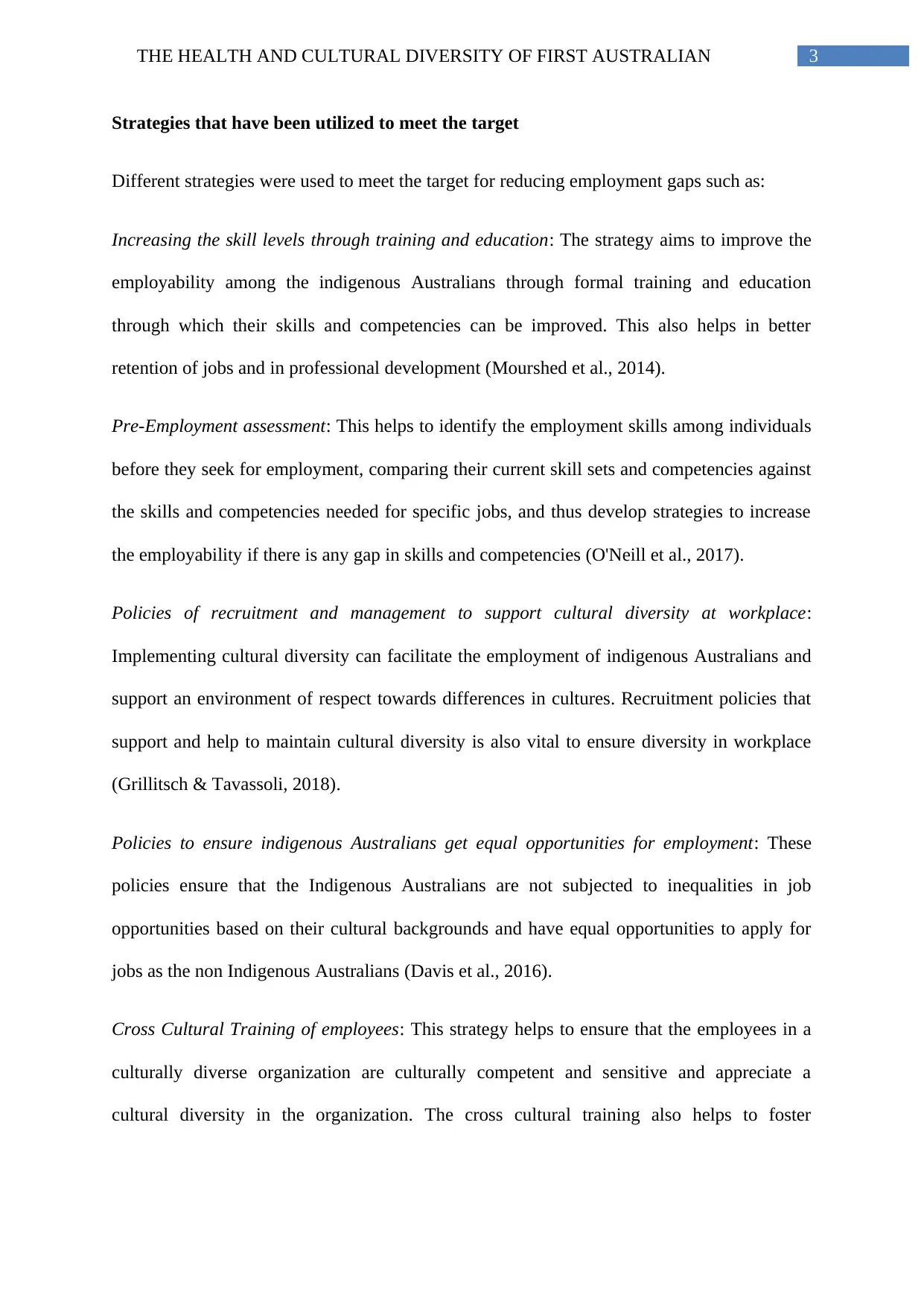
3THE HEALTH AND CULTURAL DIVERSITY OF FIRST AUSTRALIAN
Strategies that have been utilized to meet the target
Different strategies were used to meet the target for reducing employment gaps such as:
Increasing the skill levels through training and education: The strategy aims to improve the
employability among the indigenous Australians through formal training and education
through which their skills and competencies can be improved. This also helps in better
retention of jobs and in professional development (Mourshed et al., 2014).
Pre-Employment assessment: This helps to identify the employment skills among individuals
before they seek for employment, comparing their current skill sets and competencies against
the skills and competencies needed for specific jobs, and thus develop strategies to increase
the employability if there is any gap in skills and competencies (O'Neill et al., 2017).
Policies of recruitment and management to support cultural diversity at workplace:
Implementing cultural diversity can facilitate the employment of indigenous Australians and
support an environment of respect towards differences in cultures. Recruitment policies that
support and help to maintain cultural diversity is also vital to ensure diversity in workplace
(Grillitsch & Tavassoli, 2018).
Policies to ensure indigenous Australians get equal opportunities for employment: These
policies ensure that the Indigenous Australians are not subjected to inequalities in job
opportunities based on their cultural backgrounds and have equal opportunities to apply for
jobs as the non Indigenous Australians (Davis et al., 2016).
Cross Cultural Training of employees: This strategy helps to ensure that the employees in a
culturally diverse organization are culturally competent and sensitive and appreciate a
cultural diversity in the organization. The cross cultural training also helps to foster
Strategies that have been utilized to meet the target
Different strategies were used to meet the target for reducing employment gaps such as:
Increasing the skill levels through training and education: The strategy aims to improve the
employability among the indigenous Australians through formal training and education
through which their skills and competencies can be improved. This also helps in better
retention of jobs and in professional development (Mourshed et al., 2014).
Pre-Employment assessment: This helps to identify the employment skills among individuals
before they seek for employment, comparing their current skill sets and competencies against
the skills and competencies needed for specific jobs, and thus develop strategies to increase
the employability if there is any gap in skills and competencies (O'Neill et al., 2017).
Policies of recruitment and management to support cultural diversity at workplace:
Implementing cultural diversity can facilitate the employment of indigenous Australians and
support an environment of respect towards differences in cultures. Recruitment policies that
support and help to maintain cultural diversity is also vital to ensure diversity in workplace
(Grillitsch & Tavassoli, 2018).
Policies to ensure indigenous Australians get equal opportunities for employment: These
policies ensure that the Indigenous Australians are not subjected to inequalities in job
opportunities based on their cultural backgrounds and have equal opportunities to apply for
jobs as the non Indigenous Australians (Davis et al., 2016).
Cross Cultural Training of employees: This strategy helps to ensure that the employees in a
culturally diverse organization are culturally competent and sensitive and appreciate a
cultural diversity in the organization. The cross cultural training also helps to foster
Paraphrase This Document
Need a fresh take? Get an instant paraphrase of this document with our AI Paraphraser
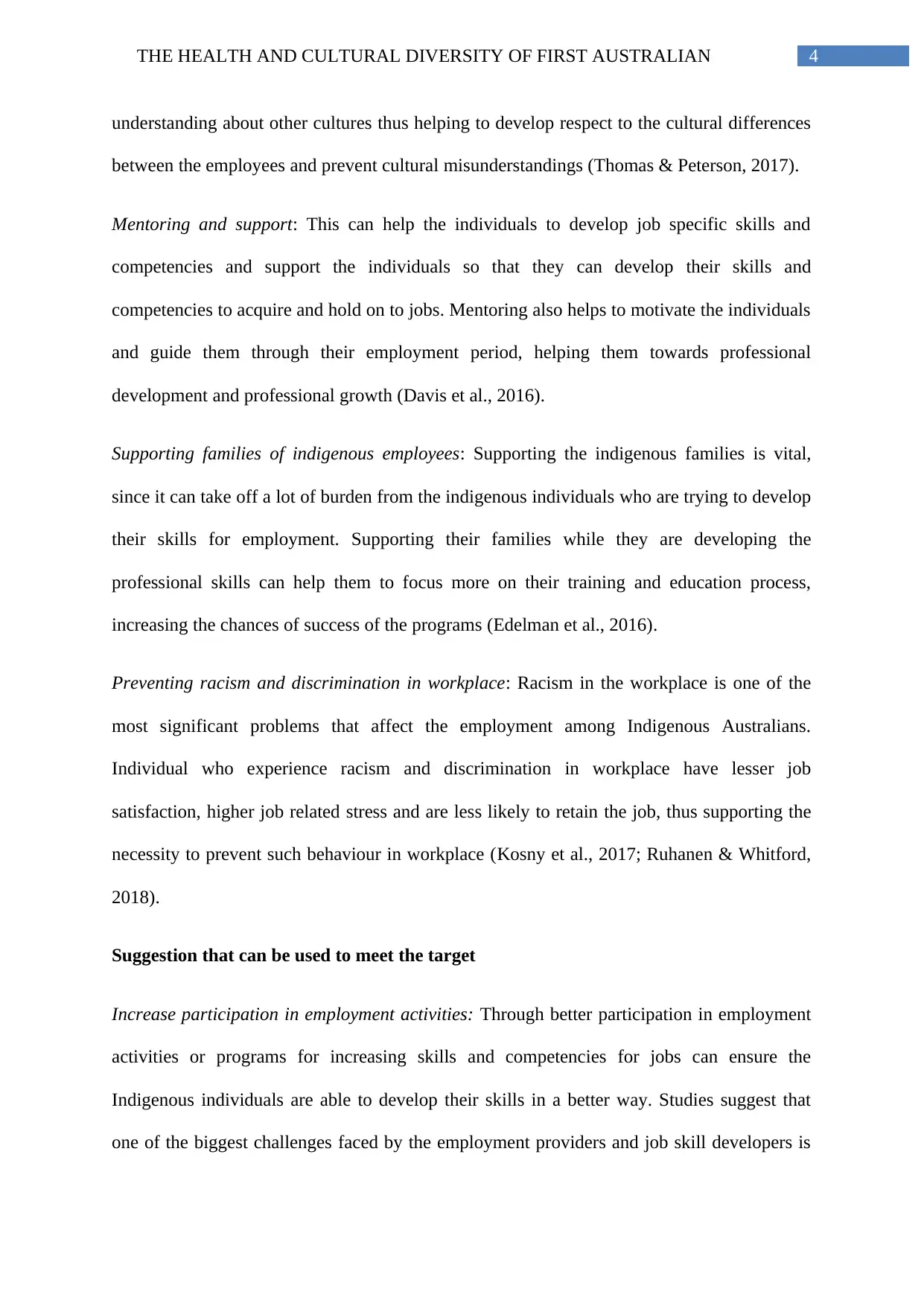
4THE HEALTH AND CULTURAL DIVERSITY OF FIRST AUSTRALIAN
understanding about other cultures thus helping to develop respect to the cultural differences
between the employees and prevent cultural misunderstandings (Thomas & Peterson, 2017).
Mentoring and support: This can help the individuals to develop job specific skills and
competencies and support the individuals so that they can develop their skills and
competencies to acquire and hold on to jobs. Mentoring also helps to motivate the individuals
and guide them through their employment period, helping them towards professional
development and professional growth (Davis et al., 2016).
Supporting families of indigenous employees: Supporting the indigenous families is vital,
since it can take off a lot of burden from the indigenous individuals who are trying to develop
their skills for employment. Supporting their families while they are developing the
professional skills can help them to focus more on their training and education process,
increasing the chances of success of the programs (Edelman et al., 2016).
Preventing racism and discrimination in workplace: Racism in the workplace is one of the
most significant problems that affect the employment among Indigenous Australians.
Individual who experience racism and discrimination in workplace have lesser job
satisfaction, higher job related stress and are less likely to retain the job, thus supporting the
necessity to prevent such behaviour in workplace (Kosny et al., 2017; Ruhanen & Whitford,
2018).
Suggestion that can be used to meet the target
Increase participation in employment activities: Through better participation in employment
activities or programs for increasing skills and competencies for jobs can ensure the
Indigenous individuals are able to develop their skills in a better way. Studies suggest that
one of the biggest challenges faced by the employment providers and job skill developers is
understanding about other cultures thus helping to develop respect to the cultural differences
between the employees and prevent cultural misunderstandings (Thomas & Peterson, 2017).
Mentoring and support: This can help the individuals to develop job specific skills and
competencies and support the individuals so that they can develop their skills and
competencies to acquire and hold on to jobs. Mentoring also helps to motivate the individuals
and guide them through their employment period, helping them towards professional
development and professional growth (Davis et al., 2016).
Supporting families of indigenous employees: Supporting the indigenous families is vital,
since it can take off a lot of burden from the indigenous individuals who are trying to develop
their skills for employment. Supporting their families while they are developing the
professional skills can help them to focus more on their training and education process,
increasing the chances of success of the programs (Edelman et al., 2016).
Preventing racism and discrimination in workplace: Racism in the workplace is one of the
most significant problems that affect the employment among Indigenous Australians.
Individual who experience racism and discrimination in workplace have lesser job
satisfaction, higher job related stress and are less likely to retain the job, thus supporting the
necessity to prevent such behaviour in workplace (Kosny et al., 2017; Ruhanen & Whitford,
2018).
Suggestion that can be used to meet the target
Increase participation in employment activities: Through better participation in employment
activities or programs for increasing skills and competencies for jobs can ensure the
Indigenous individuals are able to develop their skills in a better way. Studies suggest that
one of the biggest challenges faced by the employment providers and job skill developers is
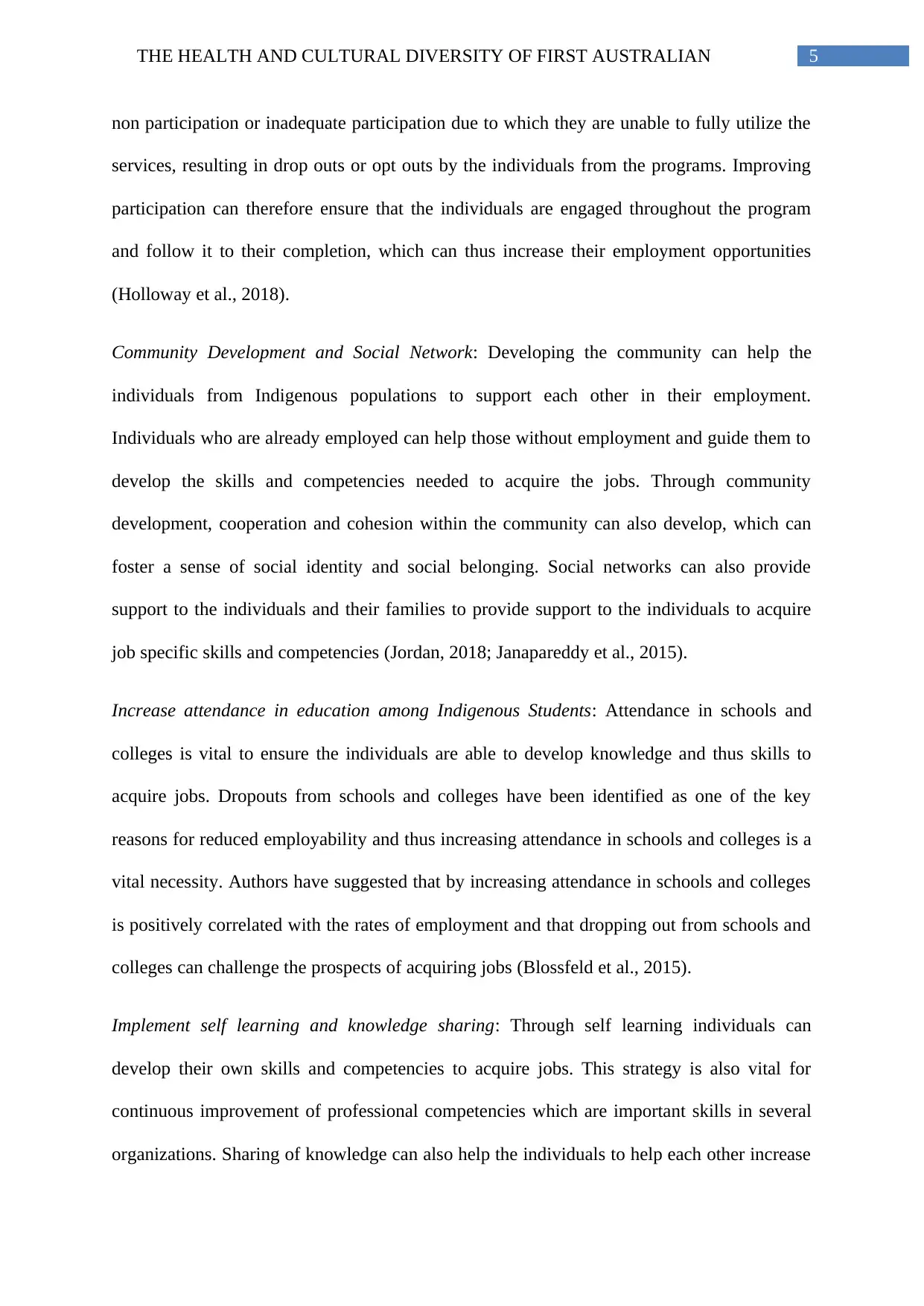
5THE HEALTH AND CULTURAL DIVERSITY OF FIRST AUSTRALIAN
non participation or inadequate participation due to which they are unable to fully utilize the
services, resulting in drop outs or opt outs by the individuals from the programs. Improving
participation can therefore ensure that the individuals are engaged throughout the program
and follow it to their completion, which can thus increase their employment opportunities
(Holloway et al., 2018).
Community Development and Social Network: Developing the community can help the
individuals from Indigenous populations to support each other in their employment.
Individuals who are already employed can help those without employment and guide them to
develop the skills and competencies needed to acquire the jobs. Through community
development, cooperation and cohesion within the community can also develop, which can
foster a sense of social identity and social belonging. Social networks can also provide
support to the individuals and their families to provide support to the individuals to acquire
job specific skills and competencies (Jordan, 2018; Janapareddy et al., 2015).
Increase attendance in education among Indigenous Students: Attendance in schools and
colleges is vital to ensure the individuals are able to develop knowledge and thus skills to
acquire jobs. Dropouts from schools and colleges have been identified as one of the key
reasons for reduced employability and thus increasing attendance in schools and colleges is a
vital necessity. Authors have suggested that by increasing attendance in schools and colleges
is positively correlated with the rates of employment and that dropping out from schools and
colleges can challenge the prospects of acquiring jobs (Blossfeld et al., 2015).
Implement self learning and knowledge sharing: Through self learning individuals can
develop their own skills and competencies to acquire jobs. This strategy is also vital for
continuous improvement of professional competencies which are important skills in several
organizations. Sharing of knowledge can also help the individuals to help each other increase
non participation or inadequate participation due to which they are unable to fully utilize the
services, resulting in drop outs or opt outs by the individuals from the programs. Improving
participation can therefore ensure that the individuals are engaged throughout the program
and follow it to their completion, which can thus increase their employment opportunities
(Holloway et al., 2018).
Community Development and Social Network: Developing the community can help the
individuals from Indigenous populations to support each other in their employment.
Individuals who are already employed can help those without employment and guide them to
develop the skills and competencies needed to acquire the jobs. Through community
development, cooperation and cohesion within the community can also develop, which can
foster a sense of social identity and social belonging. Social networks can also provide
support to the individuals and their families to provide support to the individuals to acquire
job specific skills and competencies (Jordan, 2018; Janapareddy et al., 2015).
Increase attendance in education among Indigenous Students: Attendance in schools and
colleges is vital to ensure the individuals are able to develop knowledge and thus skills to
acquire jobs. Dropouts from schools and colleges have been identified as one of the key
reasons for reduced employability and thus increasing attendance in schools and colleges is a
vital necessity. Authors have suggested that by increasing attendance in schools and colleges
is positively correlated with the rates of employment and that dropping out from schools and
colleges can challenge the prospects of acquiring jobs (Blossfeld et al., 2015).
Implement self learning and knowledge sharing: Through self learning individuals can
develop their own skills and competencies to acquire jobs. This strategy is also vital for
continuous improvement of professional competencies which are important skills in several
organizations. Sharing of knowledge can also help the individuals to help each other increase
⊘ This is a preview!⊘
Do you want full access?
Subscribe today to unlock all pages.

Trusted by 1+ million students worldwide
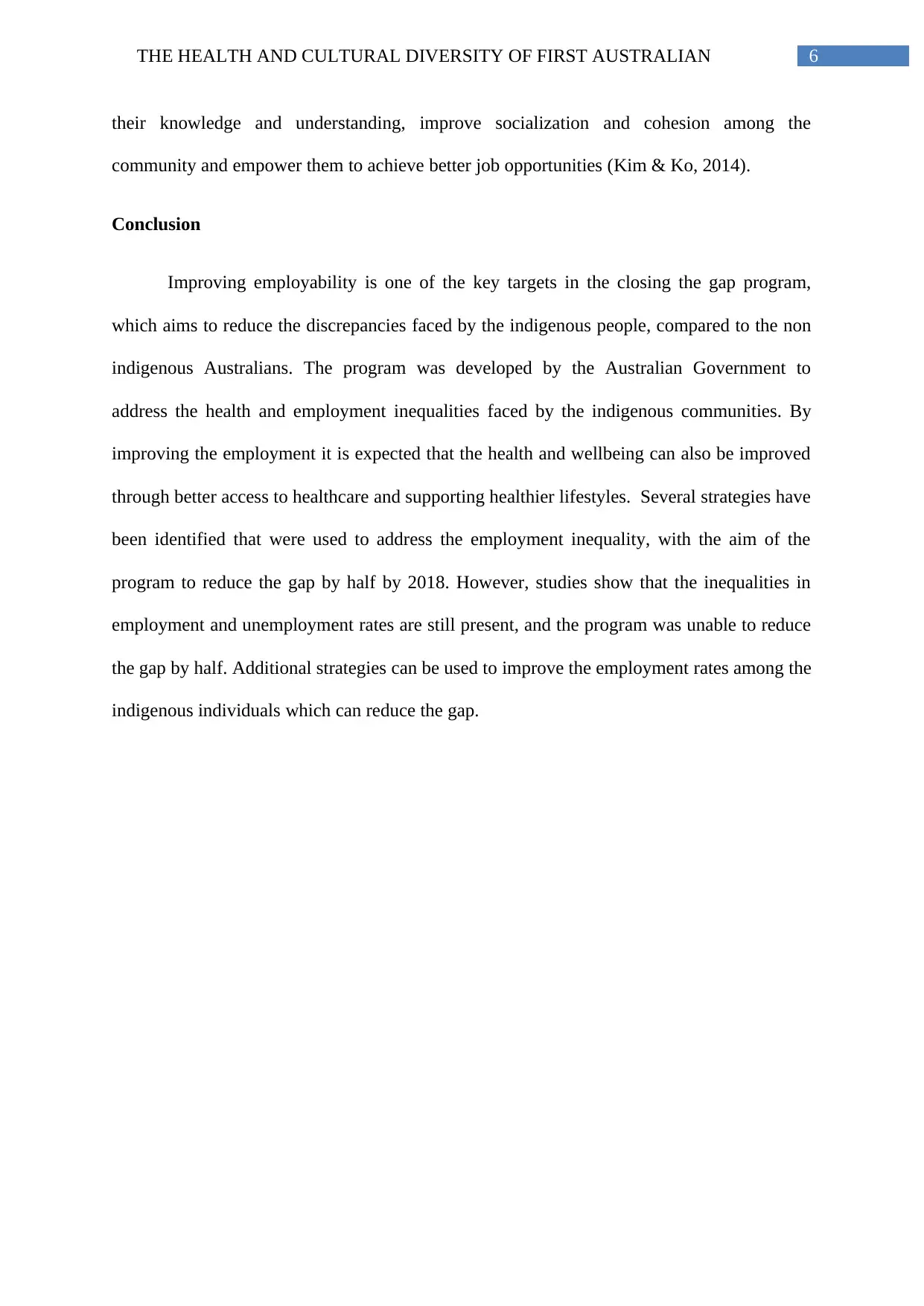
6THE HEALTH AND CULTURAL DIVERSITY OF FIRST AUSTRALIAN
their knowledge and understanding, improve socialization and cohesion among the
community and empower them to achieve better job opportunities (Kim & Ko, 2014).
Conclusion
Improving employability is one of the key targets in the closing the gap program,
which aims to reduce the discrepancies faced by the indigenous people, compared to the non
indigenous Australians. The program was developed by the Australian Government to
address the health and employment inequalities faced by the indigenous communities. By
improving the employment it is expected that the health and wellbeing can also be improved
through better access to healthcare and supporting healthier lifestyles. Several strategies have
been identified that were used to address the employment inequality, with the aim of the
program to reduce the gap by half by 2018. However, studies show that the inequalities in
employment and unemployment rates are still present, and the program was unable to reduce
the gap by half. Additional strategies can be used to improve the employment rates among the
indigenous individuals which can reduce the gap.
their knowledge and understanding, improve socialization and cohesion among the
community and empower them to achieve better job opportunities (Kim & Ko, 2014).
Conclusion
Improving employability is one of the key targets in the closing the gap program,
which aims to reduce the discrepancies faced by the indigenous people, compared to the non
indigenous Australians. The program was developed by the Australian Government to
address the health and employment inequalities faced by the indigenous communities. By
improving the employment it is expected that the health and wellbeing can also be improved
through better access to healthcare and supporting healthier lifestyles. Several strategies have
been identified that were used to address the employment inequality, with the aim of the
program to reduce the gap by half by 2018. However, studies show that the inequalities in
employment and unemployment rates are still present, and the program was unable to reduce
the gap by half. Additional strategies can be used to improve the employment rates among the
indigenous individuals which can reduce the gap.
Paraphrase This Document
Need a fresh take? Get an instant paraphrase of this document with our AI Paraphraser
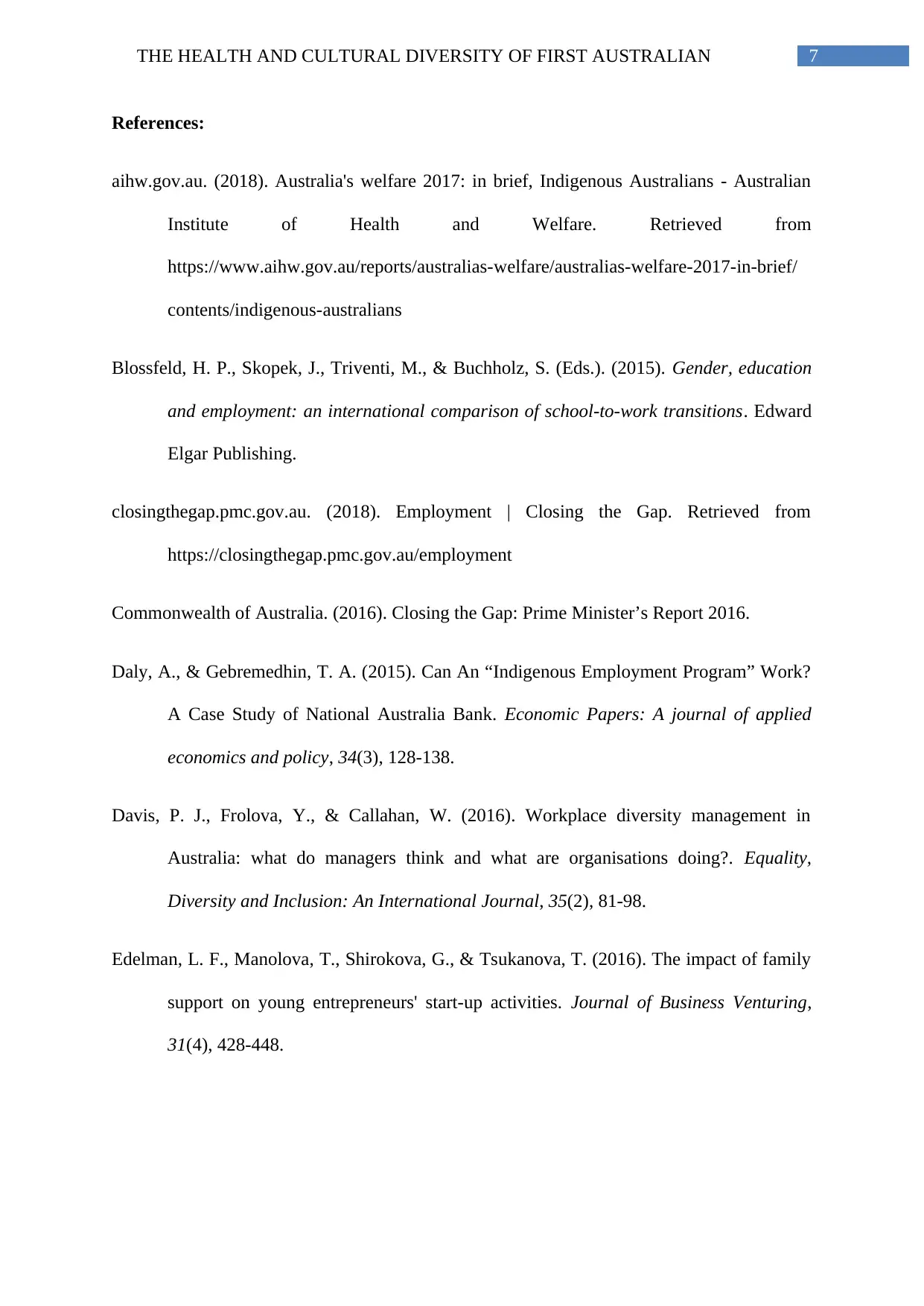
7THE HEALTH AND CULTURAL DIVERSITY OF FIRST AUSTRALIAN
References:
aihw.gov.au. (2018). Australia's welfare 2017: in brief, Indigenous Australians - Australian
Institute of Health and Welfare. Retrieved from
https://www.aihw.gov.au/reports/australias-welfare/australias-welfare-2017-in-brief/
contents/indigenous-australians
Blossfeld, H. P., Skopek, J., Triventi, M., & Buchholz, S. (Eds.). (2015). Gender, education
and employment: an international comparison of school-to-work transitions. Edward
Elgar Publishing.
closingthegap.pmc.gov.au. (2018). Employment | Closing the Gap. Retrieved from
https://closingthegap.pmc.gov.au/employment
Commonwealth of Australia. (2016). Closing the Gap: Prime Minister’s Report 2016.
Daly, A., & Gebremedhin, T. A. (2015). Can An “Indigenous Employment Program” Work?
A Case Study of National Australia Bank. Economic Papers: A journal of applied
economics and policy, 34(3), 128-138.
Davis, P. J., Frolova, Y., & Callahan, W. (2016). Workplace diversity management in
Australia: what do managers think and what are organisations doing?. Equality,
Diversity and Inclusion: An International Journal, 35(2), 81-98.
Edelman, L. F., Manolova, T., Shirokova, G., & Tsukanova, T. (2016). The impact of family
support on young entrepreneurs' start-up activities. Journal of Business Venturing,
31(4), 428-448.
References:
aihw.gov.au. (2018). Australia's welfare 2017: in brief, Indigenous Australians - Australian
Institute of Health and Welfare. Retrieved from
https://www.aihw.gov.au/reports/australias-welfare/australias-welfare-2017-in-brief/
contents/indigenous-australians
Blossfeld, H. P., Skopek, J., Triventi, M., & Buchholz, S. (Eds.). (2015). Gender, education
and employment: an international comparison of school-to-work transitions. Edward
Elgar Publishing.
closingthegap.pmc.gov.au. (2018). Employment | Closing the Gap. Retrieved from
https://closingthegap.pmc.gov.au/employment
Commonwealth of Australia. (2016). Closing the Gap: Prime Minister’s Report 2016.
Daly, A., & Gebremedhin, T. A. (2015). Can An “Indigenous Employment Program” Work?
A Case Study of National Australia Bank. Economic Papers: A journal of applied
economics and policy, 34(3), 128-138.
Davis, P. J., Frolova, Y., & Callahan, W. (2016). Workplace diversity management in
Australia: what do managers think and what are organisations doing?. Equality,
Diversity and Inclusion: An International Journal, 35(2), 81-98.
Edelman, L. F., Manolova, T., Shirokova, G., & Tsukanova, T. (2016). The impact of family
support on young entrepreneurs' start-up activities. Journal of Business Venturing,
31(4), 428-448.
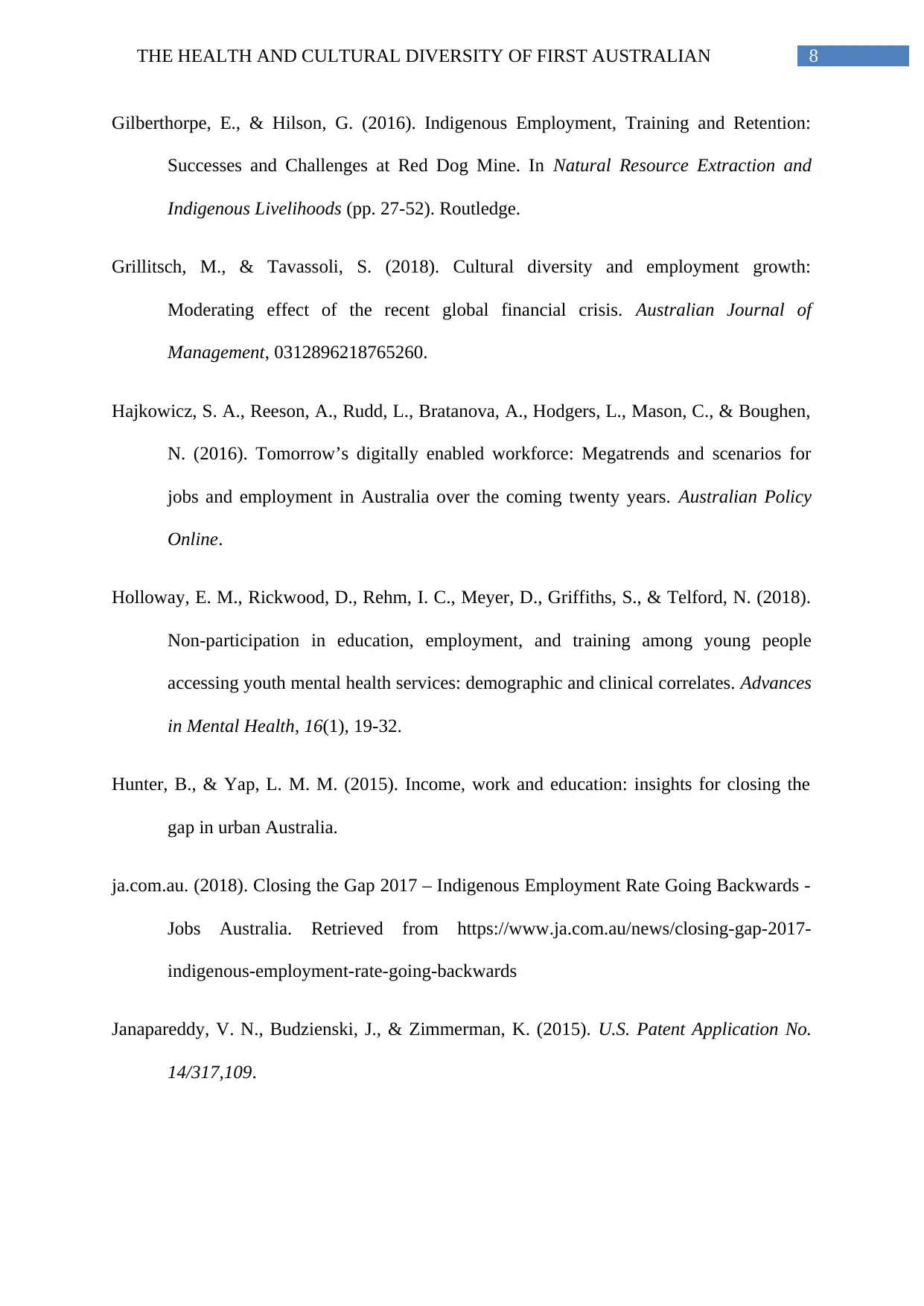
8THE HEALTH AND CULTURAL DIVERSITY OF FIRST AUSTRALIAN
Gilberthorpe, E., & Hilson, G. (2016). Indigenous Employment, Training and Retention:
Successes and Challenges at Red Dog Mine. In Natural Resource Extraction and
Indigenous Livelihoods (pp. 27-52). Routledge.
Grillitsch, M., & Tavassoli, S. (2018). Cultural diversity and employment growth:
Moderating effect of the recent global financial crisis. Australian Journal of
Management, 0312896218765260.
Hajkowicz, S. A., Reeson, A., Rudd, L., Bratanova, A., Hodgers, L., Mason, C., & Boughen,
N. (2016). Tomorrow’s digitally enabled workforce: Megatrends and scenarios for
jobs and employment in Australia over the coming twenty years. Australian Policy
Online.
Holloway, E. M., Rickwood, D., Rehm, I. C., Meyer, D., Griffiths, S., & Telford, N. (2018).
Non-participation in education, employment, and training among young people
accessing youth mental health services: demographic and clinical correlates. Advances
in Mental Health, 16(1), 19-32.
Hunter, B., & Yap, L. M. M. (2015). Income, work and education: insights for closing the
gap in urban Australia.
ja.com.au. (2018). Closing the Gap 2017 – Indigenous Employment Rate Going Backwards -
Jobs Australia. Retrieved from https://www.ja.com.au/news/closing-gap-2017-
indigenous-employment-rate-going-backwards
Janapareddy, V. N., Budzienski, J., & Zimmerman, K. (2015). U.S. Patent Application No.
14/317,109.
Gilberthorpe, E., & Hilson, G. (2016). Indigenous Employment, Training and Retention:
Successes and Challenges at Red Dog Mine. In Natural Resource Extraction and
Indigenous Livelihoods (pp. 27-52). Routledge.
Grillitsch, M., & Tavassoli, S. (2018). Cultural diversity and employment growth:
Moderating effect of the recent global financial crisis. Australian Journal of
Management, 0312896218765260.
Hajkowicz, S. A., Reeson, A., Rudd, L., Bratanova, A., Hodgers, L., Mason, C., & Boughen,
N. (2016). Tomorrow’s digitally enabled workforce: Megatrends and scenarios for
jobs and employment in Australia over the coming twenty years. Australian Policy
Online.
Holloway, E. M., Rickwood, D., Rehm, I. C., Meyer, D., Griffiths, S., & Telford, N. (2018).
Non-participation in education, employment, and training among young people
accessing youth mental health services: demographic and clinical correlates. Advances
in Mental Health, 16(1), 19-32.
Hunter, B., & Yap, L. M. M. (2015). Income, work and education: insights for closing the
gap in urban Australia.
ja.com.au. (2018). Closing the Gap 2017 – Indigenous Employment Rate Going Backwards -
Jobs Australia. Retrieved from https://www.ja.com.au/news/closing-gap-2017-
indigenous-employment-rate-going-backwards
Janapareddy, V. N., Budzienski, J., & Zimmerman, K. (2015). U.S. Patent Application No.
14/317,109.
⊘ This is a preview!⊘
Do you want full access?
Subscribe today to unlock all pages.

Trusted by 1+ million students worldwide
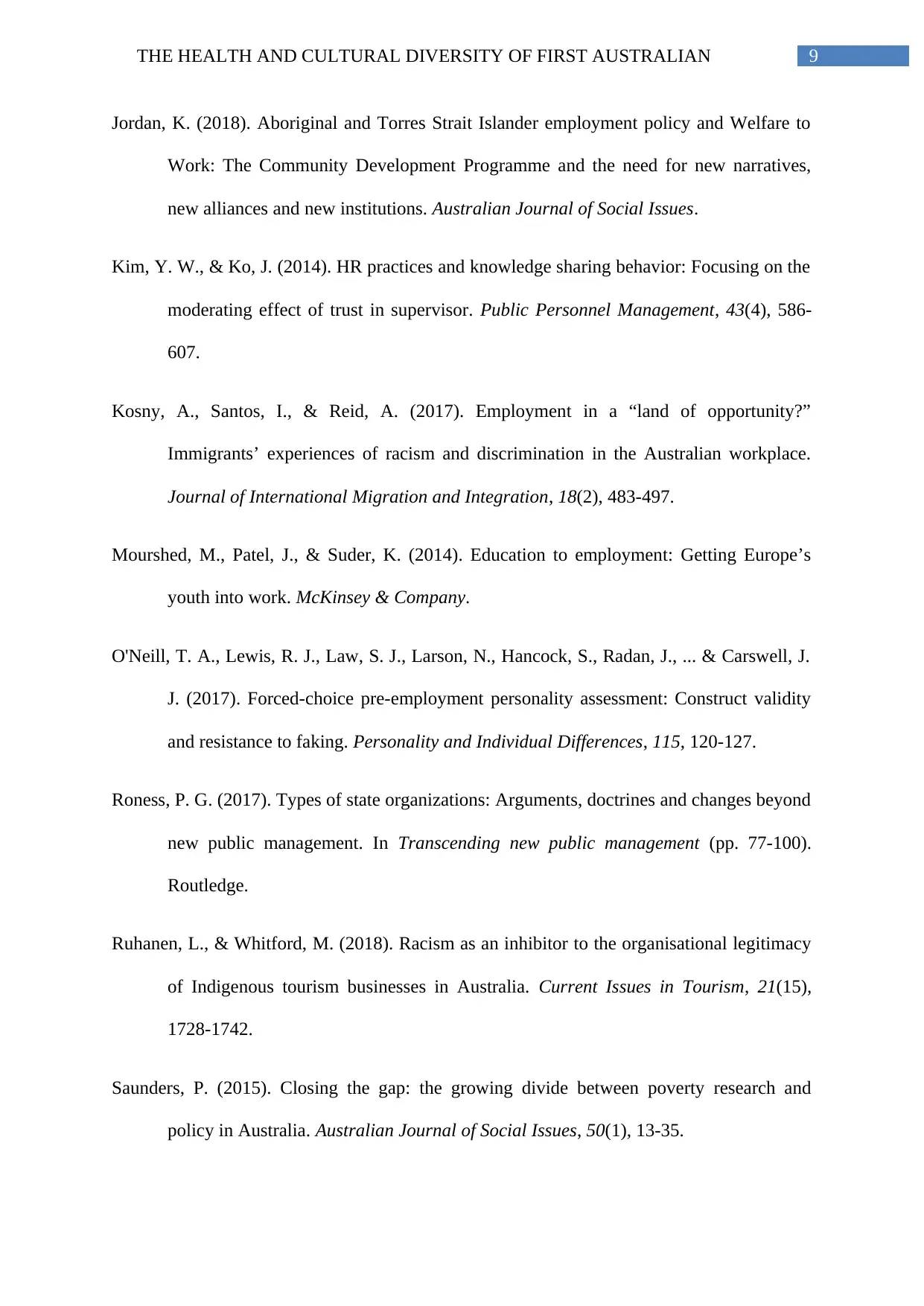
9THE HEALTH AND CULTURAL DIVERSITY OF FIRST AUSTRALIAN
Jordan, K. (2018). Aboriginal and Torres Strait Islander employment policy and Welfare to
Work: The Community Development Programme and the need for new narratives,
new alliances and new institutions. Australian Journal of Social Issues.
Kim, Y. W., & Ko, J. (2014). HR practices and knowledge sharing behavior: Focusing on the
moderating effect of trust in supervisor. Public Personnel Management, 43(4), 586-
607.
Kosny, A., Santos, I., & Reid, A. (2017). Employment in a “land of opportunity?”
Immigrants’ experiences of racism and discrimination in the Australian workplace.
Journal of International Migration and Integration, 18(2), 483-497.
Mourshed, M., Patel, J., & Suder, K. (2014). Education to employment: Getting Europe’s
youth into work. McKinsey & Company.
O'Neill, T. A., Lewis, R. J., Law, S. J., Larson, N., Hancock, S., Radan, J., ... & Carswell, J.
J. (2017). Forced-choice pre-employment personality assessment: Construct validity
and resistance to faking. Personality and Individual Differences, 115, 120-127.
Roness, P. G. (2017). Types of state organizations: Arguments, doctrines and changes beyond
new public management. In Transcending new public management (pp. 77-100).
Routledge.
Ruhanen, L., & Whitford, M. (2018). Racism as an inhibitor to the organisational legitimacy
of Indigenous tourism businesses in Australia. Current Issues in Tourism, 21(15),
1728-1742.
Saunders, P. (2015). Closing the gap: the growing divide between poverty research and
policy in Australia. Australian Journal of Social Issues, 50(1), 13-35.
Jordan, K. (2018). Aboriginal and Torres Strait Islander employment policy and Welfare to
Work: The Community Development Programme and the need for new narratives,
new alliances and new institutions. Australian Journal of Social Issues.
Kim, Y. W., & Ko, J. (2014). HR practices and knowledge sharing behavior: Focusing on the
moderating effect of trust in supervisor. Public Personnel Management, 43(4), 586-
607.
Kosny, A., Santos, I., & Reid, A. (2017). Employment in a “land of opportunity?”
Immigrants’ experiences of racism and discrimination in the Australian workplace.
Journal of International Migration and Integration, 18(2), 483-497.
Mourshed, M., Patel, J., & Suder, K. (2014). Education to employment: Getting Europe’s
youth into work. McKinsey & Company.
O'Neill, T. A., Lewis, R. J., Law, S. J., Larson, N., Hancock, S., Radan, J., ... & Carswell, J.
J. (2017). Forced-choice pre-employment personality assessment: Construct validity
and resistance to faking. Personality and Individual Differences, 115, 120-127.
Roness, P. G. (2017). Types of state organizations: Arguments, doctrines and changes beyond
new public management. In Transcending new public management (pp. 77-100).
Routledge.
Ruhanen, L., & Whitford, M. (2018). Racism as an inhibitor to the organisational legitimacy
of Indigenous tourism businesses in Australia. Current Issues in Tourism, 21(15),
1728-1742.
Saunders, P. (2015). Closing the gap: the growing divide between poverty research and
policy in Australia. Australian Journal of Social Issues, 50(1), 13-35.
Paraphrase This Document
Need a fresh take? Get an instant paraphrase of this document with our AI Paraphraser

10THE HEALTH AND CULTURAL DIVERSITY OF FIRST AUSTRALIAN
Thomas, D. C., & Peterson, M. F. (2017). Cross-cultural management: Essential concepts.
Sage Publications.
Thomas, D. C., & Peterson, M. F. (2017). Cross-cultural management: Essential concepts.
Sage Publications.
1 out of 11
Related Documents
Your All-in-One AI-Powered Toolkit for Academic Success.
+13062052269
info@desklib.com
Available 24*7 on WhatsApp / Email
![[object Object]](/_next/static/media/star-bottom.7253800d.svg)
Unlock your academic potential
Copyright © 2020–2025 A2Z Services. All Rights Reserved. Developed and managed by ZUCOL.





